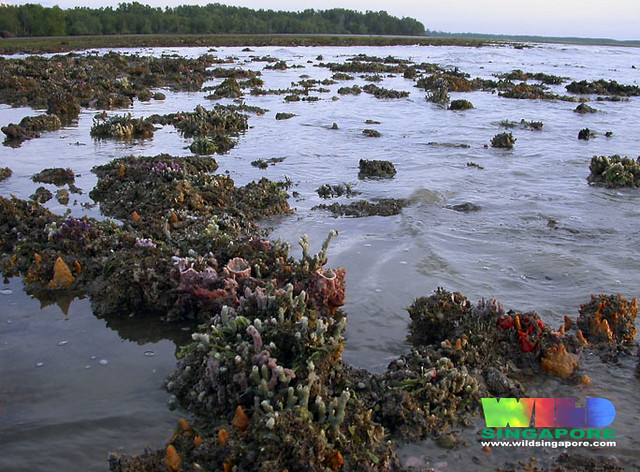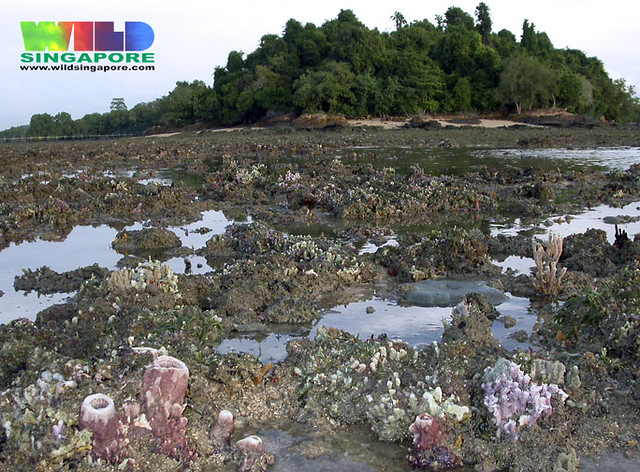The area looks similar to what we saw on our last survey in Jul 2018, and marks a slow improvement since our survey in Jul 2016.
Chek Jawa is looking more like it used to before the devastating mass deaths in 2007 which wiped out the sponges and many other animals here. Chek Jawa was also hit by the 300-tonne oil spill in the East Johor Strait in Jan 2017. So it was a relief to see such a magnificent array of marine life there this morning.
I was glad to see many sponges of various kinds all along the survey route from the House No. 1 Jetty to the Chek Jawa Front Beacon! I first noticed improved sponge diversity during our survey in Jul 2016, which improved further during our Jun 2017 survey and in our Jul 2018 survey. Yellow bumpy sponges continued to be the most common, forming large clumps all over the shore edge.
The area now looks more and more like what I used to see nearly 20 years ago! Here's what I saw today.
Here's what I saw in the past.
 |
| Chek Jawa July 2002 |
 |
| Chek Jawa July 2002 (before the boardwalk was built) |
The edge near the beacon was a flowery soft coral garden! With many small colonies in pretty pastel colours. I also saw many small Ball flowery soft corals, Chay Hoon saw the White soft coral snapping shrimp that live in these. As for sea anemones, there were many Haddon's carpet anemones, some large Swimming anemones. On the rubble, many Posy anemones.
There were also many small sea fans, mostly Candelabra sea fans and Gnarled sea fans, plus one Asparagus sea fan and some Skinny sea fans.
There were many small to medium sized Boulder pore corals. All were unbleached and had no dead patches. Some were brown, others dark blue or green. I saw several medium sized Flowery disk corals. As usual, there were patches of Zebra coral and some Neat hexagonal corals.
I only saw one large Knobbly sea stars on the outer edge, on our last survey in Jul 2018 we saw many large ones here, with a few smaller ones on the seagrass areas. I saw only one huge Cake sea stars, one our last survey we saw several. I hope they are still alright some where on the shore. I saw some large Biscuit sea stars, with small ones on the seagrass areas and big ones on the rubbly area. I also saw many Painted sand stars in the seagrass area on the way to the survey site, and Rene saw one small Eight armed sea star. I saw one Blue feather star. As usual, there were not many small sea cucumbers, just a sprinkling of Thorny sea cucumbers. But there were many large Garlic bread sea cucumbers on the rubbly area, and many Ball sea cucumbers buried in the sandy areas.
It was good to spot some Onyx cowries and one Miliaris cowrie. There were many octopuses, those in the water often went to hide near my foot. Some tiny ones stranded at low tide were pale with stress. But they will soon be covered as the tide turns.
Similar to our last survey in Jul 2018 and in Jun 217, seagrasses are doing well with Smooth ribbon seagrass now growing thickly west of the floating pontoon. The seagrasses were lush. Growing thickly and leaf blades green and clear of growths (epiphytes). There were lots of nice green Needle seagrass (skinny leaf blades), Fern seagrass, Spoon seagrass (big and small leaf blades). Smooth ribbon seagrasses have taken over most of the seagrass meadows near the coral rubble area.
I came across two clumps of Tape seagrass growing on the outer edge of the rubbly area. Most were near the Beacon. They had longish leaf blades. I only came across one dugong feeding trail near House No. 1. Today we did not come across any fresh nets or traps along our survey route. Hurray!
Today we noticed many small and large holes dug out in the seagrass areas, probably by wild boar foraging on the shore. Our shores are important to all kinds of wild animals including terrestrial ones.
Thanks to NParks for permission and support to do these predawn low spring tide surveys of Chek Jawa. Thanks also to Chay Hoon for making all the transport arrangements. And the team for helping to cover as much ground as we can during the narrow low tide window. Thank you!
What is the fate of Chek Jawa?
Chek Jawa and Pulau Sekudu may be affected by the 2030 landuse plan by the Ministry of National Development. The plan includes plans for a road link (black line) from the mainland jumping off at Punggol, crossing to Pulau Ubin through Chek Jawa to jump off to Pulau Tekong before circling back to the mainland on Changi East. Proposed reclamation (in yellow) will bury Pasir Ris shores, Pulau Sekudu and Chek Jawa as well as a large amount of shore at Changi Beach. I feel it is thus important to update our understanding of what is going on in the field at these sites including Chek Jawa and Pulau Sekudu.
 |
| click on images for larger view. |
Among the Proposed Areas for Immediate Conservation Priority, the Singapore Blue Plan 2018 proposes that the intertidal and subtidal marine areas of Pulau Ubin to be designated Marine Reserve.
The proposed area would include Tanjung Chek Jawa, the largest known intertidal area in northern Singapore. Considered one of the richest in Singapore, Chek Jawa comprises many adjacent ecosystems: coastal hill forest, mangrove areas, rocky shores, seagrass meadows, coral communities, and sandy areas. Chek Jawa remains an icon of celebration and hope for many Singaporeans since its reprieve from reclamation in 2001.
 |
| The Chek Jawa boardwalk allows easy experience of the ecosystems there! |
DOWNLOAD the Plan, SUPPORT the Plan! More on the Singapore Blue Plan 2018 site.
Posts by others on this trip
Marcus Ng
Chay Hoon
Joleen Chan
Rene Ong
Kelvin Yong
Others on this trip: Jeanette, Andrew














